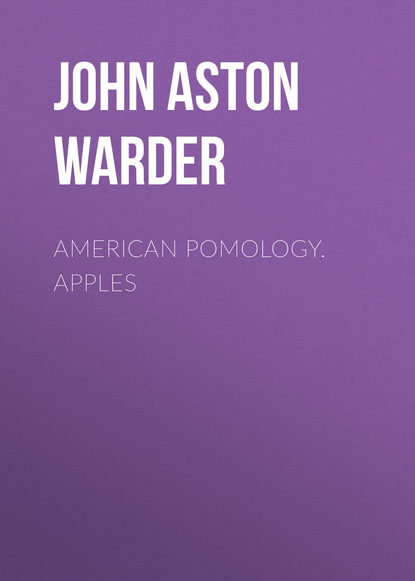 Полная версия
Полная версияAmerican Pomology. Apples
A choice dessert fruit. Succeeds well in parts of Kentucky.
English RussetOrigin unknown. Procured from Mr. C.C. Cary, near Louisville, Kentucky.
Fruit large, globular, flattened, somewhat one-sided; Surface uneven, green; Dots minute, russety and russet streaks.
Basin medium, uneven; Eye small, closed.
Cavity acute, wavy, russeted; Stem medium, green.
Core medium, heart-shaped, closed, clasping; Seeds numerous, plump and angular, some imperfect; Flesh yellow, firm, breaking, juicy; Flavor acid; Quality good; Use, kitchen; Season, December, January.
Golden Pearmain.—[Of Kentucky.]This is another very promising Southern variety, received from J.S. Downer, of Kentucky; Origin unknown; he procured it from Tennessee.
Tree vigorous, but tardy and shy in bearing; Shoots stout, dark; Foliage medium.
Fruit small to medium, globular, rather conical, truncated, lop-sided; Surface yellow, blushed and russeted.
Basin abrupt, wide, regular; Eye large, open.
Cavity acute, regular; Stem short to medium, slender.
Core somewhat open, meeting the eye; Seeds plump and imperfect; Flesh yellow, breaking, fine-grained; Flavor acid, aromatic, sprightly; Quality very good, almost best; Use, dessert; Season, December, February.—See Columbian Russet.
Green Russet.—[N.C.]Specimens from Reuben Ragan.
Fruit quite large, globular, slightly oblate, regular; Surface yellow, blushed dull red; Dots green, indented, russet veined.
Basin medium, regular; Eye medium, open.
Cavity deep, acute, regular, brown; Stem medium, thick.
Core regular, wide, closed, clasping; Axis short; Seeds numerous, plump, dark; Flesh yellowish white, breaking, granular; Flavor sub-acid; Quality only good, for culinary use; Season, December, January.
Hampton's RussetFruit small, globular-truncate, to flat; Surface yellow russet, bronzed, broken russet stripes; Dots scattered, large, yellow.
Basin wide, regular; Eye large, open, green.
Cavity medium, regular, brown; Stem long, inclined.
Core medium, round, closed, meeting the eye; Seeds numerous, pointed, brown; Flesh yellow, tender, breaking, fine-grained; Flavor sub-acid, rich; Quality good; Use, table; Season, December.
Knox Russet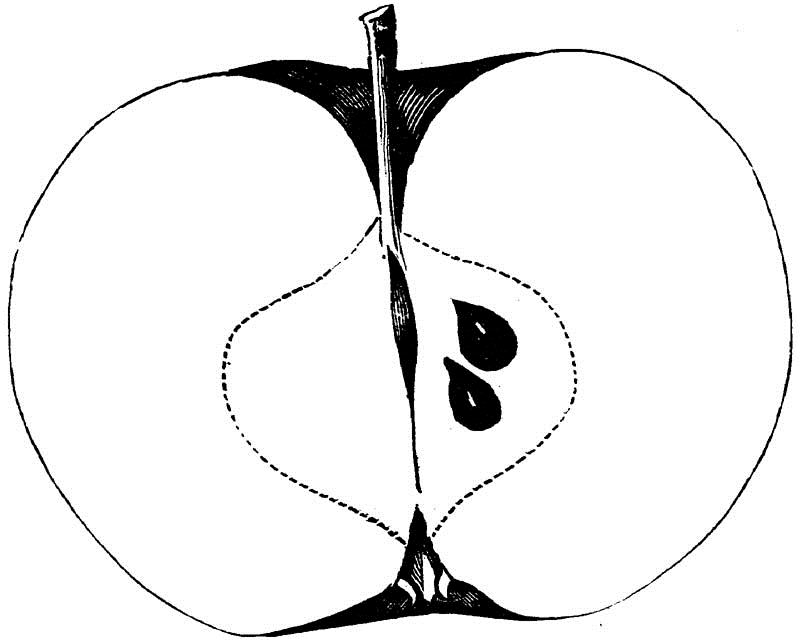
Fig. 241.—KNOX RUSSET.
A very nice little apple, found in the orchard of J. Knox, Pittsburgh, Pennsylvania; trees obtained from near Greensburgh, Pennsylvania. Tree spreading, very productive; Shoots slender.
Fruit small to medium, globular, somewhat conic, regular; Surface smooth, yellow green, blushed, covered with light russet.
Basin shallow, regular; Eye medium, open; Segments reflexed.
Cavity deep, acute, regular; Stem long, red.
Core round, regular, slightly open, clasping the eye; Seeds numerous, short, plump; Flesh yellow, very fine-grained; Flavor mild sub-acid, aromatic; Quality good to very good; Use, dessert; Season, December, January.
Pryor's Red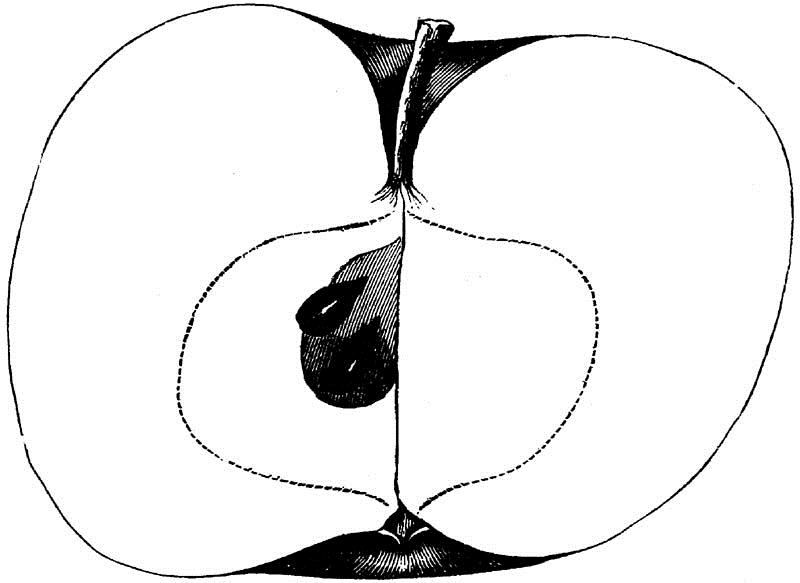
Fig. 242.—PRYOR'S RED.
This southern apple, probably from Virginia, has been carried through all the Western States, where it is a great favorite, though there are some objectors, on account of its having shown signs of failure in certain situations. The fruit is singularly affected by change of soil and climate; thus, on the Ohio River, it is seen quite flat and regular, with a dull green russeted skin, becoming yellow and ruddy; in one part of the State of Indiana, on limestone, it is gibbous, round, often very large, and covered with a rich cinnamon russet, while on the coal measures, west of the center of the State, it is smaller, regular, and distinctly striped deep red on red, with very little russet. Specimens from Rochester, New York, have been shown with scarcely a trace of russet, and having the stripes as distinct and almost as beautiful as those of a Duchess of Oldenburgh, so that no southern or western man would have recognized it for his home favorite. The distinctive leather-cracking about the eye was present, however, in all.
Tree thrifty, growth upright, twiggy, attaining large size, productive when old; Shoots slender, reddish olive, speckled; Foliage scattering, folded, grayish green; Subject to leaf-blight.
Fruit large, globular-oblate, often unequal; Surface greenish, or dull red, striped, russeted; Dots numerous, large, gray.
Basin shallow, regular or plaited, leather-cracked; Eye small, closed.
Cavity shallow, acute, often lipped; Stem medium.
Core round, regular, closed, meeting the eye; Seeds numerous, angular, pointed; Flesh yellow, tender, melting, fine-grained, juicy; Flavor sub-acid, rich; Quality best; Use, table, kitchen; Season, December, February.
Red RussetOrigin Hampton Falls, New Hampshire.
Tree very vigorous and productive; resembling Baldwin in almost every particular.
"Fruit large, roundish, conic; Skin yellow, shaded with dull red and deep carmine in the sun, and thickly covered with gray dots, and an appearance of rough russet on most of the surface; Stalk rather short and thick, inserted in a medium cavity, surrounded with thin russet; Calyx nearly closed; Segments long, recurved, in a narrow, uneven basin; Flesh yellow, solid, crisp, tender, with an excellent, rich, sub-acid flavor, somewhat resembling Baldwin; Season, January to April."—Downing.
This fruit is rarely seen in the West. It has been thought by some to have originated as a sport from the Baldwin.
Rolen's Keeper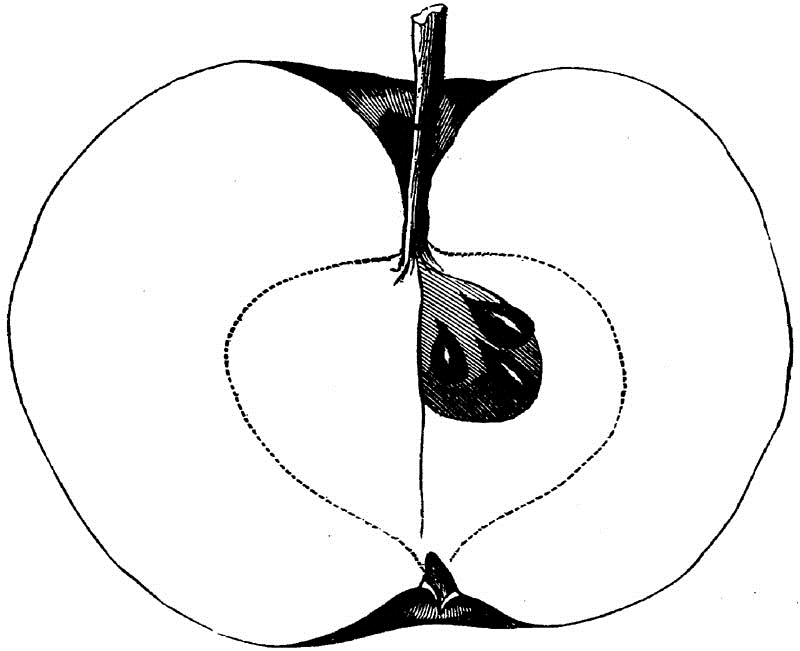
Fig. 243.—ROLEN'S KEEPER.
Received from H.N. Gillett, Lawrence County, Ohio. Origin not given.
Fruit medium, round, regular; Surface rough, splashed red on russet; Dots scattered, small, white.
Basin shallow, regular, leather-cracked; Eye small, closed.
Cavity deep, acute, regular; Stem long, slender.
Core roundish-ovate, regular, closed, clasping; Seeds very numerous, short, plump; Flesh greenish yellow, fine-grained; Flavor acid, rich; Quality good to very good; Use, table; Season, March, April.
Very promising as a keeper.
Rustycoat Milam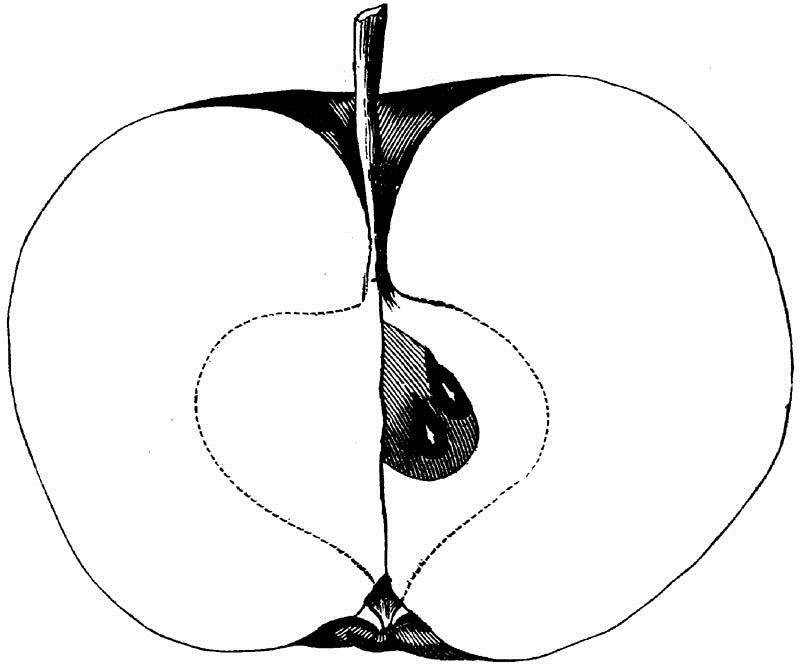
Fig. 244.—RUSTYCOAT MILAM.
Fruit medium, globular, conic, regular; Surface russeted; Dots minute, prominent.
Basin narrow, abrupt, shallow; Eye small, closed.
Cavity acute, regular; Stem medium to long.
Core medium, regular, closed, clasping; Seeds numerous, pointed, plump; Flesh greenish yellow, breaking, fine-grained, tender; Flavor sub-acid, aromatic; Quality good; Use, table; Season, December to February.
CLASS III.—ROUND APPLESORDER II.—IRREGULARSECTION 1.—SWEETSUB-SECTION 1.—SELF-COLORED OR BLUSHEDMote's Sweet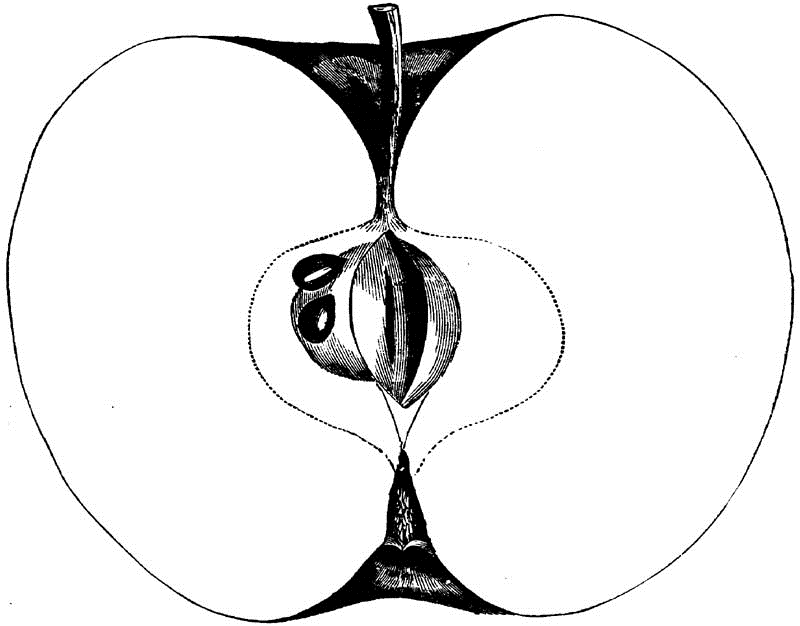
Fig. 245.—MOTE'S SWEET.
This seedling from the Stillwater Sweet, grown by L.S. Mote, of Miami County, Ohio, is quite an improvement upon its parent, which has obtained a high reputation as a choice autumnal sweet apple. Tree round, spreading, vigorous; Shoots pale; Foliage large, wide, finely serrated, and rather pale.
Fruit large, globular, somewhat flattened, or conic-truncated, rather angular; Surface very smooth, greenish yellow to whitish, with a rare faint blush; Dots scattered, gray, often rosy, whitish bases.
Basin medium, abrupt, wavy; Eye medium, long, closed.
Cavity deep, wide, wavy; Stem long, yellow, curved.
Core medium, open, clasping; Seeds numerous, angular, pale; Flesh yellow, very fine-grained, almost melting, juicy; Flavor very sweet, pleasant; Use, table and kitchen; Quality best; Season, September. One of the most delicious sweet apples.
Northern SweetOrigin unknown; supposed to be Vermont. Tree sufficiently healthy and productive. Not generally nor extensively cultivated.
Fruit large, globular, somewhat flattened, angular or regular; Surface smooth, very pale yellow, rarely blushed; Dots minute, with white bases.
Basin deep, abrupt, regular; Eye long, closed.
Cavity rather wide, regular, green; Stem medium.
Core very small, closed, almost clasping; Seeds numerous, short; Flesh whitish, breaking, juicy; Flavor very sweet; Quality pretty good; Use, baking; Season, September, in Northern Indiana and Illinois. Downing says "rich and excellent; September and October."
Swaar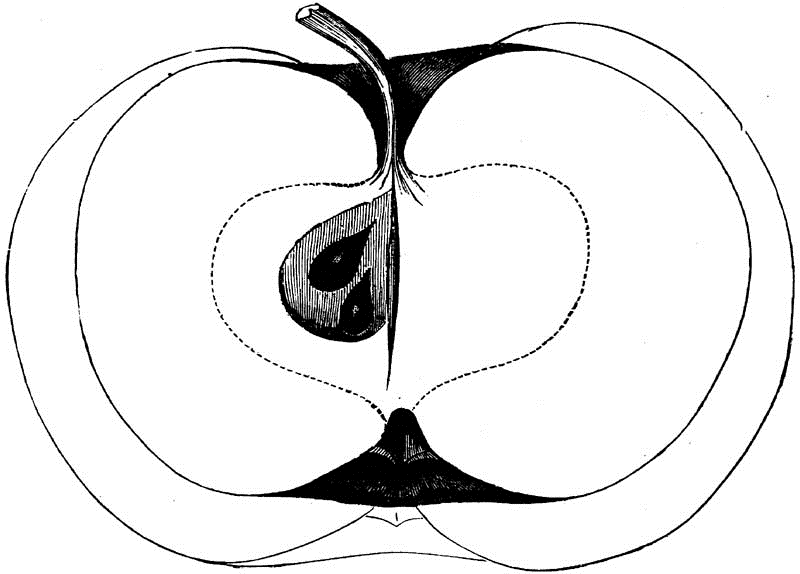
Fig. 246.—SWAAR.
Origin on the banks of the Hudson, in New York State. Tree vigorous, spreading, productive; Shoots stout, dark colored; Foliage large, curled.
Fruit large, form variable, being sometimes flat, where unusually developed, generally roundish, somewhat flattened, more or less angular or flattened on the sides, but not ribbed; Surface not smooth, often rough, greenish yellow, bronzed, becoming a dead golden yellow when ripe; Dots large, numerous.
Basin medium, wide, regular; Eye small, not long, closed.
Cavity wide, regular or wavy, green; Stem long, curved, pretty stout.
Core medium, regular, heart-shaped, closed, clasping; Seeds numerous, angular, pale; Flesh very heavy, yellow, fine-grained; Flavor very mild sub-acid, or sweet, very rich; Quality best; Use, table and kitchen; Season, March.
CLASS III.—ROUND APPLESORDER II.—IRREGULARSECTION 1.—SWEETSUB-SECTION 2.—STRIPEDBailey Sweet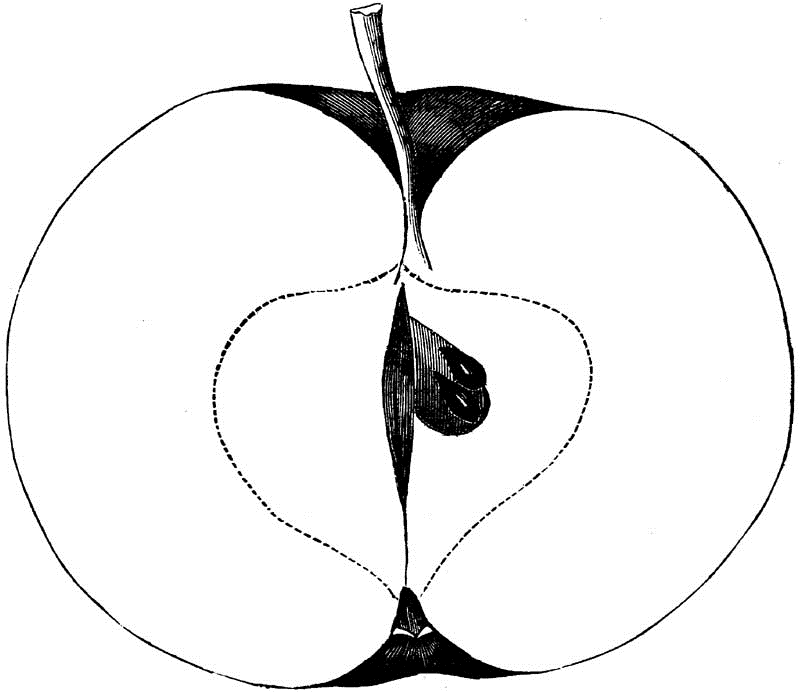
Fig. 247.—BAILEY SWEET.
From Wyoming County, New York. Tree vigorous, productive.
Fruit large, round, sometimes flattened, sometimes angular or ribbed; Surface smooth, mottled, mixed and striped deep red; Dots numerous, large, gray.
Basin narrow, abrupt, regular or folded; Eye small, closed.
Cavity regular, acute green; Stem long.
Core rather large, turbinate, open, clasping; Seeds numerous, angular, dark; Flesh yellow, tender, fine-grained, juicy; Flavor very sweet, rich; Quality good to very good; Use, kitchen, table; Season, October.
A very valuable variety also for stock.
Brittle Sweet"Origin unknown; good grower, and very productive.
"Fruit above medium, roundish, approaching conic, sometimes elongated, angular; Skin greenish yellow, shaded and splashed with crimson, sprinkled with gray dots; Stem short, inserted in a broad, shallow cavity; Calyx closed, set in a small corrugated basin; Flesh yellowish, crisp, tender, juicy, sweet, and excellent; Season, September, October."—Downing.
Hull BlossomThis is an Eastern or European variety, which I have not seen in the West. Specimens from Massachusetts.
Fruit small, roundish-truncate, or flattened, uneven; Surface smooth, yellow, mixed and striped, carmine; Dots large, yellow.
Basin shallow, folded; Eye small, closed.
Cavity deep, wavy; Stem short.
Core small, closed, roundish, meeting the eye; Seeds large, pale; Flesh yellow, fine-grained; Flavor sweet; Quality good to very good; Use, table, kitchen; Season, November.
Sweet Pearmain"This variety, according to Downing and Thomas, is the English Sweeting; but, according to Manning, the English Sweeting is the Ramsdell's Sweeting of Downing. This fruit is extensively grown in Central Ohio, and further West, suiting well the rich soils; keeping finely all winter; highly valued for baking or eating."
"Fruit medium size or often above; Form roundish, slightly angular; Color dull red, rough russet dots, and blueish bloom; Stem long, slender; Cavity deep, wide, open; Calyx woolly; Basin medium; Flesh yellowish, tender, moderately juicy, sweet; Core medium, with outer or concentric lines; Seeds ovate, pyriform, dark brown; Season, December to March."—Elliott.
I am not familiar with the above, but find a very strong resemblance in the characters to those of my Red Winter Pearmain, Class II, I, 2, 2, from which, however, Elliott's outline would exclude it.
Willis SweetThis apple is supposed to have originated on Long Island, where it is highly valued for baking.
Tree vigorous, productive; Fruit medium, round, somewhat angular, striped red, very sweet and rich; Use, baking and stock.
CLASS III.—ROUND APPLESORDER II.—IRREGULARSECTION 1.—SWEETSUB-SECTION 3.—RUSSETNoneCLASS III.—ROUND APPLESORDER II.—IRREGULARSECTION 2.—SOURSUB-SECTION 1.—SELF-COLOREDAmerican Golden PippinGOLDEN PIPPIN, of Downing.—NEW YORK GREENING, &C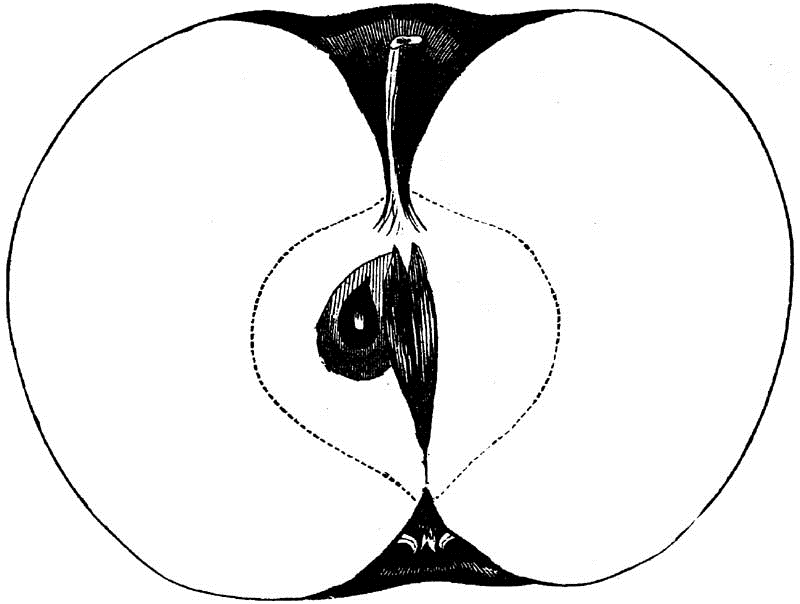
Fig. 248.—AMERICAN GOLDEN PIPPIN.
Having mislaid my notes of this apple, I am obliged to quote Mr. Downing's description of this fine fruit, which is believed to be American; cultivated in parts of New York, and found to be profitable.
"Growth strong, similar to that of Rhode Island Greening, but less drooping, making a round, spreading head; does not bear young, but very productive when a little advanced, and a popular fruit where known."
"Form variable, oblate, globular or conic, angular or ribbed; Stem stout, short, inserted in a deep cavity; Calyx closed, set in an irregular basin; Skin fine golden yellow, thinly sprinkled with dots, sometimes slightly netted with thin russet; Flesh yellowish, tender, juicy, nearly melting, with a rich, refreshing, almost vinous, aromatic flavor; Core rather large; November to February."
Brooke's Pippin"Origin, Essex County, Virginia. The original tree is very large, bears regular and large crops of fruit, which is always fair, of the largest size, keeps well till May; Flesh fine, yellow, juicy and rich, and of the finest flavor; young trees grow very thriftily."—[H.R. Robey, Fredericksburgh, Va.]
Fruit large, roundish, inclining to conical, obscurely ribbed, greenish yellow, faintly blushed.
Basin small, shallow, wavy, sometimes furrowed; Eye medium, closed.
Cavity deep, wavy, brown; Stem short, thick.
Flesh yellow, crisp, juicy, fine-grained; Flavor acid, spicy, rich; Quality very good; Season, November to March.
As grown in Indiana, both tree and fruit resemble the Newtown Pippin in appearance, and may prove identical after further trial.
Champlain.—[Downing.]PAPER—PAPER-SKINThis very delicate fruit was exhibited before the Ohio Pomological Society by A.L. Benedict, of Morrow County, as the Paper apple. He obtained the cions from the celebrated apple region, Grand Isle, Vermont, where it is sometimes called Champlain, and where it had been introduced from Rhode Island, without a name, by his friend Macomber. My friend Benedict informs me that "the growth of the tree is strong and stocky, and that the fruit never scabs nor rots on the tree. It is increasing in esteem as it becomes better known, and is preferred to the Red Astrachan, ripening with it. When sent to J.J. Thomas, he thought it synonymous with the Primate, but Jos. Newcomber, having both varieties growing side by side, assured me they were quite unlike, and that the Paper was much the better apple of the two."
Tree medium size, vigorous, stocky.
Fruit full medium, globular, rather conical, angular; Surface smooth, yellowish green, slightly blushed; Dots minute, indented.
Basin small, abrupt, folded; Eye small, long, closed.
Cavity acute, wavy, green; Stem long, slender.
Core medium, round, slightly open, clasping; Seeds numerous, angular, dark; Flesh white, tender, fine-grained, juicy; Flavor sub-acid, aromatic, delicate; Quality best; Use, the dessert especially; Season, August, September.
Drap d'OrVRAI DRAP D'OR.—[Dahamel.]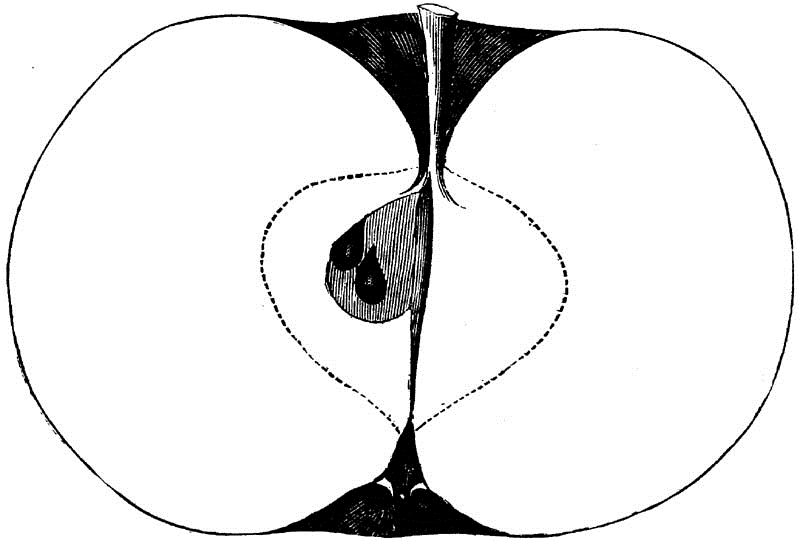
Fig. 249.—DRAP D'OR.
This is an old French variety, respecting which there is some uncertainty among cultivators.
Fruit large, globular, but variable, being conical-truncate to oblate; Surface smooth, pale waxen yellow, rarely blushed.
Basin wide, plaited; Eye small, closed.
Cavity wide, wavy, brown; Stem long, inclined, yellow or red, angular.
Core large, regular, closed, clasping; Seeds numerous, angular, long; Flesh pale yellow, breaking, fine-grained, juicy; Flavor sub-acid, aromatic; Quality good to best; Use, market, kitchen, table; Season, August, September.
For the table its place is supplanted by the Primate, Dyer and others.
Dyer, or Pomme RoyalePOMMEWATER, in Illinois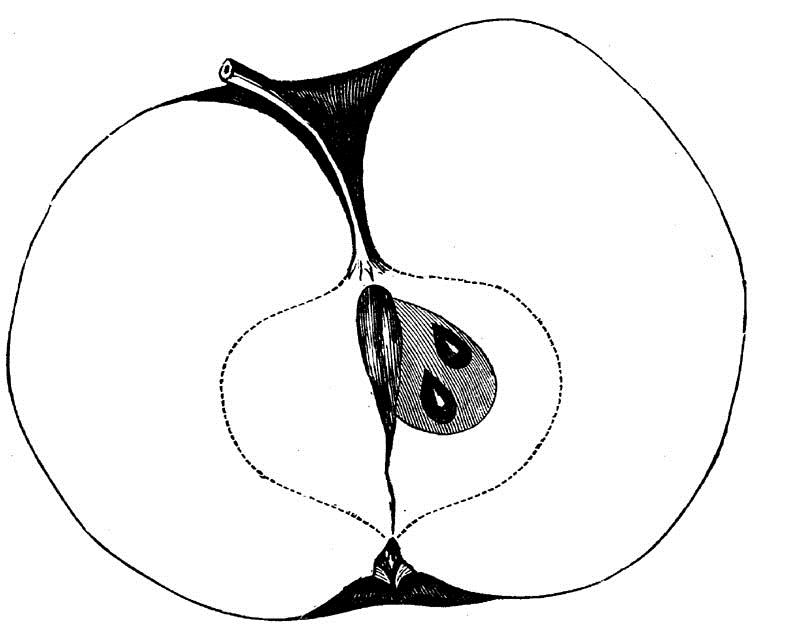
Fig. 250.—DYER, OR POMME ROYALE.
Believed to be a French apple, but named Dyer by the Massachusetts Horticultural Society, in the belief that it was a seedling of Rhode Island.
Tree of moderate vigor, spreading, not very productive.
Fruit medium to large, globular, uneven, somewhat angular; Surface not smooth, pale yellow, vein-russeted; Dots numerous, minute, dark.
Basin medium, shallow, folded or plaited; Eye small, closed.
Cavity deep, acute, lipped, brown; Stem long, slender.
Core regular, round, open or closed, clasping; Seeds numerous, plump, short; Flesh yellowish, very tender, very fine-grained, very juicy; Flavor sub-acid, aromatic, rich, delicate; Quality best; Use, the dessert; Season, September, October.
Not attractive in appearance, but very fine for the amateur.
EwaltOrigin Pennsylvania. Introduced by Dr. Brinckle in his ad-interim reports to the Pennsylvania Horticultural Society. Mr. Waring considers it a valuable winter apple. Tree vigorous, handsome grower in the nursery; Shoots erect, dark colored; an early, regular bearer.
Fruit large, very handsome, roundish, rather angular; Surface smooth, yellow, with clear bright red in the sun, not striped; Dots numerous about the base, greenish.
Basin medium, narrow, plaited; Eye medium, closed.
Cavity medium, acute; Stem short.
Flesh tender, fine-grained; Flavor acid, becoming mild, aromatic, sprightly; Quality very good; Season, February to April.
Golden BallA favorite Maine apple. Tree vigorous, productive, hardy.
Fruit large, round, ribbed; Surface smooth, greenish yellow; Dots few, distinct, white bases.
Basin deep, abrupt, folded; Eye large, closed.
Cavity narrow; Stem medium.
Core indistinct, open, clasping; Seeds defective; Flesh yellowish, tender, juicy; Flavor sub-acid, rich; Quality good; Use, table, kitchen, market; Season, December to March in the North.
Morgan White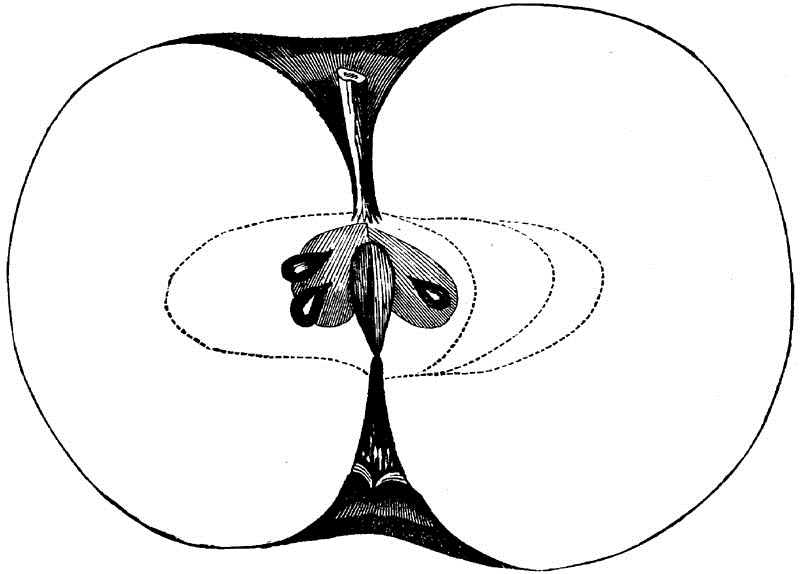
Fig. 251.—MORGAN WHITE.
Origin unknown. Sent from Morgan County, Illinois, by Professor J.B. Turner, of Jacksonville.
Fruit large, globular, somewhat flattened, irregular, ribbed, uneven; Surface smooth, greenish, marked with gray striæ, rarely a faint blush; Dots white, large.
Basin abrupt, ribbed; Eye small but long, closed.
Cavity deep, acute, wavy; Stem short to medium.
Core small, very wide, open, clasping; Axis short; Seeds numerous, plump, short; Flesh greenish white, breaking, tender, fine-grained, juicy; Flavor acid to sub-acid, agreeable; Quality good; Use, kitchen and table; Season, September to January.
Peck's Pleasant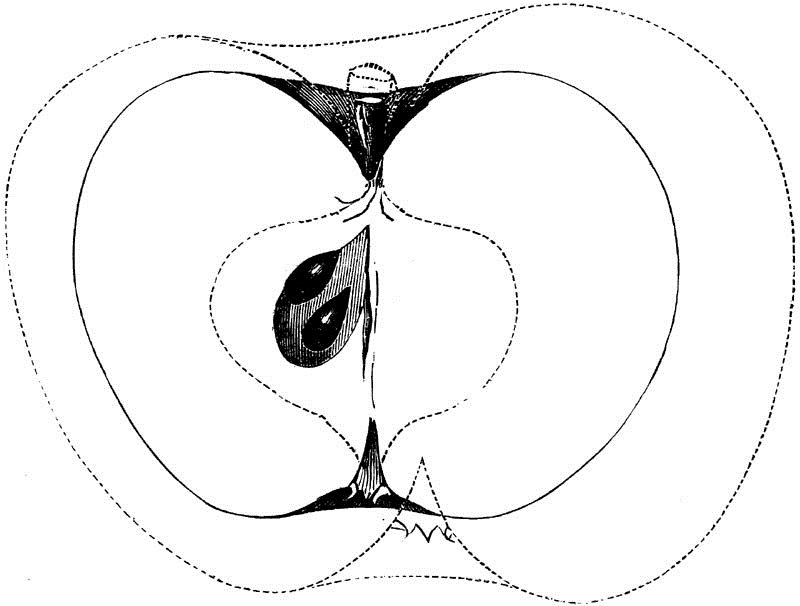
Fig. 252.—PECK'S PLEASANT.
This fine fruit is credited to Rhode Island. The tree is healthy, spreading, moderately vigorous, but productive, and a regular bearer. This apple is said to resemble the Newtown Pippin, but I have never been able to trace any resemblance, except that both are green; at any rate there is no danger of the merest tyro in pomology confounding the two varieties. There is, however, a remarkable diversity in the fruit arising from the different soils and climates in which it is cultivated, North and South, and while, like many other varieties, its size is greatly developed, its texture and flavor are depreciated in the migrations southward.
Fruit large, flattened, globular, somewhat angular, or flattened, sometimes having a shallow sulcus or furrow on one side; Surface smooth, yellow or orange, being sometimes faintly blushed; Dots gray, with white bases.
Basin rather shallow and folded; Eye small and open, calycinal segments being short.
Cavity wide, but often lipped, brown; Stem short, very thick, clubbed or knobby.
Core large, closed, clasping the eye; Seeds numerous, angular; Flesh yellow, tender, breaking, fine-grained; Flavor sub-acid and somewhat aromatic; of first quality in the North; Use, table, kitchen or market; Season, December to January, or later.
Primate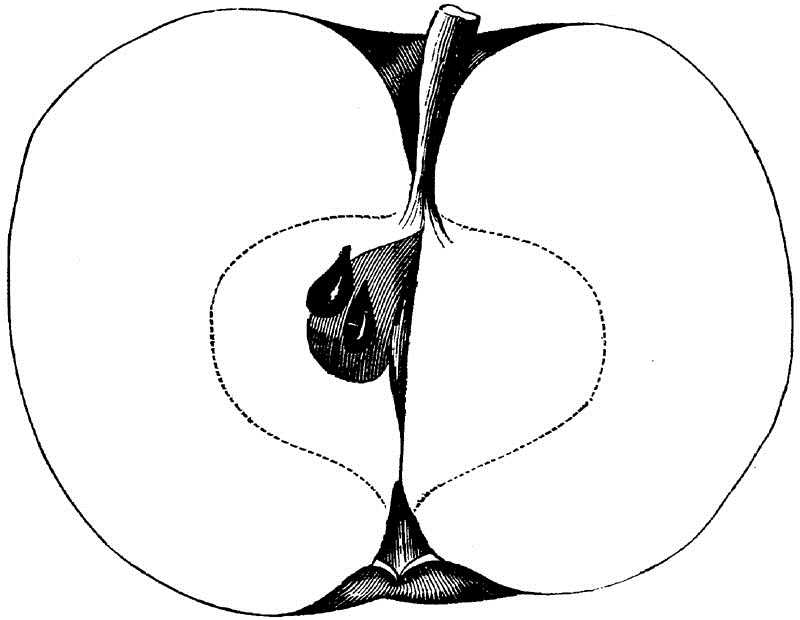
Fig. 253.—PRIMATE.
This delicious table apple has strong claims upon our admiration, on account of its good qualities as a dessert fruit, for the extreme delicacy of its skin and flesh render it unfit for market; it is therefore not profitable for the commercial orchard.
Tree thrifty, stocky, vigorous, strongly branched, productive; Shoots stout, short, light olive; Buds prominent, foliage pale green.
Fruit full medium, globular, angular, irregular; Surface smooth, greenish-yellow, becoming almost white, sometimes faintly blushed; Dots minute.
Basin abrupt, folded; Eye small but long, closed; Segments reflexed.
Cavity acute, wavy, green; Stem medium to long, thick.
Core medium, round, closed, clasping; Seeds numerous, angular, long, dark; Flesh greenish-white, very tender, fine-grained; Flavor mild sub-acid, very agreeable; Quality best; Use, the dessert; Season, July and August.
ProgressNot having had the good fortune to study this apple, I quote the description given by Downing:
"A native of Middletown, Connecticut. Tree a moderate grower and forms a handsome head, bears early and very productive.
"Size above medium, rather globular, inclining to conic, sometimes oblate, somewhat angular; Stem short, inserted into a round cavity, surrounded by russet; Calyx large, partially closed, set in a shallow, open basin; Skin smooth, yellow, with a sunny cheek, sometimes a few scattered, gray dots; Flesh solid, tender, crisp, juicy, with a very refreshing, vinous flavor. Ripe October until April."
QuinceCOLE'S QUINCE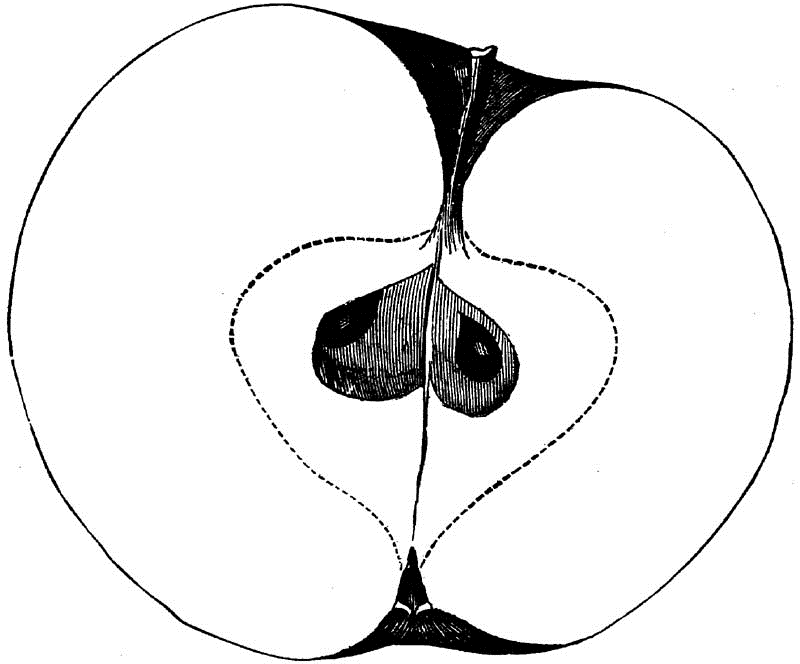
Fig. 254.—QUINCE.
This does not appear to be exactly the same as that described by Coxe, and later by Downing. This fruit is not very extensively cultivated. The specimens described are from that precise pomologist T.T. Lyon, of Michigan.
Fruit full medium, globular, angular, ribbed; Surface smooth, greenish-yellow, pale.
Basin narrow, folded, plaited; Eye small, closed.
Cavity acute, wavy; Stem medium, yellow.
Core oval, closed, meeting the eye; Seeds numerous, angular, plump, brown; Flesh yellowish-white, tender, fine-grained, juicy; Flavor sub-acid, aromatic; Quality good for cooking; Season, November to January.
SeptemberThis apple is highly esteemed by Mr. W.G. Waring, of Center County, Pennsylvania, where it originated.
Tree hardy and vigorous, a good and regular bearer.
"Fruit large, globular, somewhat depressed, slightly conic, angular; Skin yellow, slightly shaded and thinly sprinkled with brown dots; Stalk short, inserted in a deep, abrupt cavity, surrounded by thin russet; Calyx partially closed, set in an open basin; Flesh yellowish, tender, juicy, with a very agreeable sub-acid flavor; October."—[Downing.]
Sheepnose.—of MearsThis substantial little apple was presented by Wm. E. Mears, a zealous horticulturist of Clermont County, Ohio, where it is considerably cultivated. Origin unknown.
Fruit medium, round, slightly conic, irregular; Surface smooth, greenish yellow, white striæ about the base, like White Winter Pearmain, which it resembles in some other respects; Dots minute.
Basin shallow, wavy; Eye long, closed.
Cavity acute, narrow, bronzed; Stem medium, knobbed.
Core roundish oval, irregular, open, clasping; Seeds numerous, plump, dark; Flesh yellowish-white, breaking, tender, juicy; Flavor sub-acid; Quality good; Use, table and kitchen; Season, December to February.



